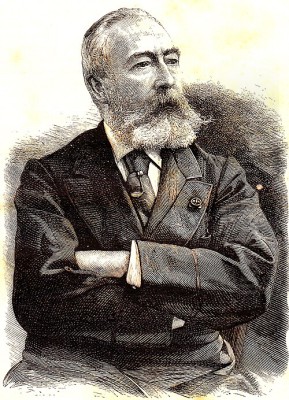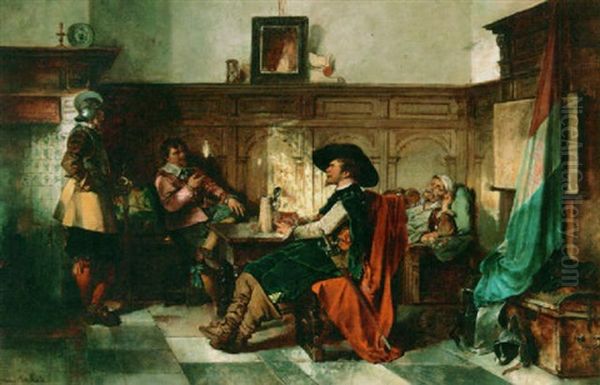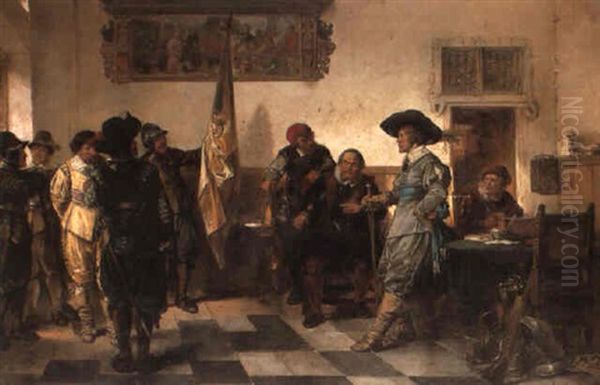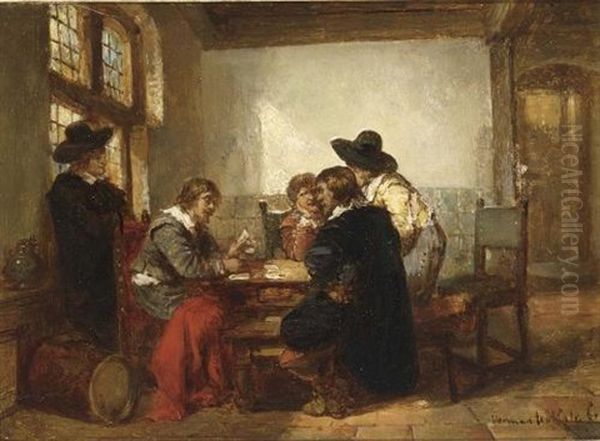
Herman Frederik Carel ten Kate stands as a significant figure in nineteenth-century Dutch art, renowned for his meticulous and evocative depictions of historical subjects, particularly scenes drawn from the Dutch Golden Age and military life. Born in The Hague on February 16, 1822, and passing away in his city of birth on March 26, 1891, Ten Kate carved a distinct niche for himself within the broader movement of Historicism that swept across Europe during his time. His works, primarily executed in oil and watercolour, captured the imagination of his contemporaries and continue to offer valuable insights into the artistic sensibilities and historical consciousness of the era.
It is critically important at the outset to distinguish Herman Frederik Carel ten Kate, the painter (1822-1891), from another notable Dutchman of a similar name: Herman Frederik Carel ten Kate, the anthropologist and ethnologist (1858-1931). The latter was a scientist known for his extensive travels and research among indigenous peoples in the Americas and Asia, holding academic degrees and pursuing a career entirely separate from the visual arts. The painter, the subject of this discussion, dedicated his life to the canvas and the brush, focusing his artistic vision on recreating moments from the Netherlands' rich past.
Early Life and Artistic Formation
Herman ten Kate's journey into the world of art began in an environment conducive to creative pursuits. His father, Jan Herman ten Kate (1790-1850), was himself an artist, known particularly for his watercolours, suggesting that young Herman was exposed to artistic practice from an early age. Born into the vibrant cultural milieu of The Hague, he showed promise early on and embarked formally on his artistic training around 1837.

A pivotal figure in his development was the respected historical and portrait painter Cornelis Kruseman (1797-1857). Studying under Kruseman provided Ten Kate with a solid foundation in academic drawing, composition, and the techniques necessary for the detailed historical narratives he would later specialise in. It is also likely that he attended or was associated with the Royal Academy of Art (Rijksakademie van beeldende kunsten) in Amsterdam at some point, further honing his skills among peers and established masters. The artistic climate in the Netherlands at this time was one of resurgence, looking back towards the glories of the seventeenth century after a period of relative decline, and Ten Kate emerged as a key participant in this revival.
His formative years may also have included travels to artistic centres like Antwerp, Brussels, or Paris, common practice for ambitious young artists seeking broader exposure. These experiences would have allowed him to study the works of Flemish masters and contemporary European artists, enriching his visual vocabulary and technical repertoire, although his core focus remained deeply rooted in Dutch traditions and history.
Artistic Style: Historicism and Realism
Herman ten Kate's artistic output is firmly situated within the Historicism movement, which emphasized the depiction of historical events, figures, and settings with a degree of accuracy and evocative detail. In the Netherlands, this often translated into a nostalgic look back at the seventeenth-century Golden Age, a period of immense national pride, cultural flourishing, and political significance. Ten Kate became a master of this genre, distinguishing his work through a combination of meticulous realism and engaging narrative.
His style contrasts with the more emotionally charged and often less historically precise approach of Romanticism, which was also prevalent during the period. Ten Kate favoured a detailed, almost documentary approach, paying close attention to the accuracy of costumes, weaponry, architectural details, and everyday objects pertinent to the era he depicted. This commitment to verisimilitude lent his paintings an air of authenticity that appealed greatly to nineteenth-century audiences interested in their national heritage.
Technically, Ten Kate was proficient in both oil painting and watercolour. His oil paintings often exhibit rich colours, careful handling of light and shadow reminiscent of the Dutch Masters he admired, and a smooth finish that allows details to stand out. His watercolours possess a particular vibrancy and fluidity, often used for slightly less formal compositions or studies, yet still demonstrating his characteristic attention to detail. His brushwork was typically precise and controlled, serving the overall goal of realistic representation and clear storytelling. Comparisons can be drawn with international contemporaries like the French painter Ernest Meissonier, who also specialized in highly detailed historical and military genre scenes.
Favourite Themes: Guardrooms and the Golden Age

A recurring and perhaps the most characteristic theme in Herman ten Kate's oeuvre is the 'kortegaardje', or guardroom scene. These paintings typically depict seventeenth-century Dutch soldiers during moments of leisure within the confines of a guardroom, tavern, or barracks interior. Viewers are invited into intimate glimpses of military life off the battlefield: soldiers smoking clay pipes, engaged in animated card games, drinking beer from earthenware jugs, polishing their armour, or simply resting and conversing.
These scenes provided Ten Kate with the perfect vehicle to showcase his skills in rendering textures – the gleam of metal armour, the rough weave of woollen uniforms, the worn wood of furniture – and in capturing human interaction and character. The settings are often dimly lit interiors, allowing for dramatic use of chiaroscuro, echoing the techniques of masters like Rembrandt van Rijn. While depicting soldiers, the emphasis is usually not on conflict but on the camaraderie, boredom, and everyday routines that defined much of military existence.
Beyond the guardroom, Ten Kate also tackled broader historical events, particularly those related to the Eighty Years' War (Dutch Revolt) and the subsequent Golden Age. His works often carried patriotic undertones, celebrating Dutch resilience, independence, and cultural identity. The meticulous recreation of historical dress and settings served not just an aesthetic purpose but also an educational one, helping to visualize the nation's past for a contemporary audience. His dedication to these themes made him a visual historian of sorts, preserving and popularizing specific aspects of Dutch heritage.
Representative Works and Notable Achievements
While a comprehensive catalogue raisonné might be complex, several works and types of works stand out as representative of Herman ten Kate's contribution. His guardroom scenes, though often generically titled (e.g., A Guardroom Interior, Soldiers Playing Cards, Resting Soldiers), form the core of his popular output and are found in numerous public and private collections, including the Rijksmuseum in Amsterdam and the Teylers Museum in Haarlem. These works perfectly encapsulate his style: detailed realism, focus on seventeenth-century military life, and atmospheric interior settings.
Specific paintings that have appeared on the art market provide further insight. The Music Room, an oil on panel measuring 65.3 x 98.1 cm, depicts a more genteel interior scene, showcasing his ability to handle different social settings within a historical context. This work was notably handled by the prominent art dealers Boussod, Valadon & Cie in the late nineteenth century. Another example, Cavaliers in an Interior (oil on panel, 43.6 x 64.3 cm), sold at Christie's in London in 1996, again highlights his focus on seventeenth-century figures within carefully rendered spaces.

Ten Kate also occasionally collaborated with other artists. A known instance involves the church interior painter Johannes Bos, where Ten Kate added the seventeenth-century figures ('stoffage') to Bos's architectural scene, a common practice demonstrating specialization within the art world of the time. His series of paintings depicting scenes from the Thirty Years' War were also highly regarded for their realism and dramatic flair.
His achievements extended beyond the easel. Ten Kate was a respected member of the Dutch artistic community. He held an honorary membership in Rotterdam's artistic society and, significantly, served as president of the prestigious Arti et Amicitiae society in Amsterdam. This position placed him at the heart of the capital's art scene, indicating the high esteem in which he was held by his peers.
Influences, Contemporaries, and Students
Herman ten Kate's art was shaped by various influences and existed within a vibrant network of contemporary artists. His primary inspiration undoubtedly came from the Dutch Golden Age masters of genre painting, such as Gerard ter Borch, Gabriel Metsu, and Pieter de Hooch, whose intimate interior scenes, attention to detail, and subtle rendering of light and texture clearly resonated with Ten Kate's own artistic goals. The dramatic lighting found in some of his works also suggests an awareness of Rembrandt van Rijn.
Among his direct contemporaries in the Netherlands who shared an interest in historical or detailed genre painting were figures like Cornelis Springer, celebrated for his meticulously rendered townscapes, and Wouter Verschuur, known for his paintings of horses, which sometimes featured in military contexts. His teacher, Cornelis Kruseman, was himself a prominent historical painter.
Ten Kate also played a significant role as an educator, passing on his skills and stylistic preferences to the next generation. His most notable students included David Bles, who became known for his own anecdotal genre scenes, often with a humorous touch; Alexander Hugo Bakker Korff, famed for his highly detailed, small-scale interior scenes often featuring women in bourgeois settings ('Bakker Korffjes'); and Charles Rochussen, another prominent painter and illustrator of historical and military subjects, whose style sometimes closely mirrored Ten Kate's own. Through these students, Ten Kate's influence extended well into the later nineteenth century. His brother, Johan Mari Henri ten Kate (1831-1910), also became a painter, initially studying under Herman and sometimes collaborating with him, further cementing the family's artistic connections.
Exhibitions, Recognition, and Royal Connections

Throughout his career, Herman ten Kate actively exhibited his work, gaining recognition both nationally and internationally. His paintings were regularly featured in the 'Exhibitions of Living Masters' (Tentoonstelling van Levende Meesters) held periodically in Dutch cities like Amsterdam, The Hague, and Rotterdam. These exhibitions were crucial platforms for artists to showcase their latest creations and connect with patrons and the public.
His reputation extended beyond the Netherlands. Evidence suggests his works were shown in major European art centres, including Brussels, Berlin, and Paris, indicating an international appreciation for his detailed historical genre scenes. This exposure helped solidify his standing as a leading exponent of Dutch Historicism on a wider stage.
His presidency of Arti et Amicitiae in Amsterdam was a significant honour, reflecting his leadership role within the Dutch art world. Furthermore, Ten Kate enjoyed connections with the Dutch monarchy. It is documented that he received recommendations or support from King William III, a form of patronage that would have undoubtedly enhanced his prestige and potentially opened doors to important commissions or sales. Such royal favour underscored his position as an established and respected artist representing national artistic traditions.
Clarifying Identity: The Painter vs. The Anthropologist
Given the potential for confusion arising from the shared name, it is essential to reiterate the distinct identities and careers of Herman Frederik Carel ten Kate, the painter (1822-1891), and Herman Frederik Carel ten Kate, the anthropologist (1858-1931). The painter, our subject, dedicated his life to visual art, specializing in historical genre scenes of the Dutch Golden Age, particularly guardroom interiors. His training was artistic, his milieu was the studios and academies of the Netherlands, and his legacy lies in his canvases.
The anthropologist, born over three decades later, pursued a scientific path. He earned a PhD, travelled extensively for research (including South America, North America, Suriname, Japan, and Indonesia), studied physical anthropology, ethnology, and linguistics, published scholarly articles on topics like craniology and indigenous cultures, and worked with museums in a curatorial or research capacity. He engaged in archaeological fieldwork, for instance, in Baja California and commented on sites like Quilmes in Argentina. His life and work belong entirely to the realm of science and exploration. There is no evidence that the painter engaged in any such academic or anthropological activities; the anecdotes related to university studies, doctoral degrees, extensive international fieldwork, and anthropological publications belong solely to his younger namesake.
Legacy and Conclusion
Herman Frederik Carel ten Kate occupies a specific yet important place in the history of Dutch art. As a leading figure of the Historicist movement in the Netherlands, he responded to a nineteenth-century desire to reconnect with the nation's celebrated past, particularly the Golden Age. His detailed and atmospheric paintings, especially the guardroom scenes, provided vivid, albeit often romanticized, glimpses into the lives of seventeenth-century soldiers and civilians.
His commitment to realism in depicting costumes, settings, and objects, combined with his skillful technique in both oil and watercolour, earned him considerable acclaim during his lifetime. He was not only a successful painter but also an influential teacher, shaping the careers of notable artists like David Bles, Alexander Hugo Bakker Korff, and Charles Rochussen, thereby extending the tradition of historical genre painting.
While the taste for Historicism eventually waned with the rise of movements like the Hague School (led by artists such as Jozef Israëls and Anton Mauve) and Impressionism towards the end of the nineteenth century, Ten Kate's work retains its appeal. His paintings offer a fascinating window into nineteenth-century historical consciousness and remain admired for their technical proficiency, narrative charm, and meticulous detail. Held in major Dutch museums and private collections worldwide, the art of Herman Frederik Carel ten Kate continues to engage viewers as a colourful and enduring chronicle of Dutch history rendered in paint.